Due to ongoing copyright infringement issues I’ve recently spent enormous amounts of time registering many thousands of my images with the U.S. Copyright Office. During that process I ran across these American Goldfinch images that I’d essentially forgotten about. They were taken almost exactly 6 years ago (11/18/2007) when I was first learning bird photography.
1/2000, f/8, ISO 400, 500 f/4, 1.4 tc, natural light, not set up
I found a small flock of these birds as they fed on sunflower seeds at Farmington Bay. Most of the birds were unapproachable but occasionally one of them would come in close as it foraged for seeds. Often, as in this case, I couldn’t get enough depth of field to get the perch entirely sharp.
These birds were losing their breeding plumage so they’re not as brightly colored as they would be earlier in the summer.
1/2000, f/8, ISO 400, 500 f/4, 1.4 tc, natural light, not set up
The sunflower seed-heads were covered with wind-blown Phragmites “fluff” which made for messy eating. Usually the birds beaks were covered with that fluff – this is one of the cleanest shots I got that showed food in the bill.
1/1600, f/9, ISO 400, 500 f/4, 1.4 tc, natural light, not set up
This shot gives you an idea of how pervasive that “fluff” was. It covered everything, including the surface of the nearby pond.
1/1600, f/9, ISO 400, 500 f/4, 1.4 tc, natural light, not set up, canvas added and blurry seed head removed
These birds were so frenetic in their feeding activities that it was difficult to catch one in a non-feeding pose.
Most songbirds, even those that are mostly seed-eaters, consume insects during the breeding season to provide protein for their growing youngsters. The American Goldfinch is an exception to that rule as it is almost exclusively a seed-eater, even during the breeding season. It is suspected that this may explain why the chicks of the nest-parasitizing Brown-headed Cowbird do not survive in goldfinch nests. The eggs hatch successfully but the cowbird chicks have retarded growth and invariably die before fledging.
There are certain groups of birds (waterfowl and some common songbirds such as these goldfinches come to mind) that haven’t received much attention on my blog in the past. This post is one of my early attempts to rectify that situation.
Ron
Addendum: As per a request from Patty Chadwick I’ve added this image (below) of a male American Goldfinch in breeding plumage – taken in early July.


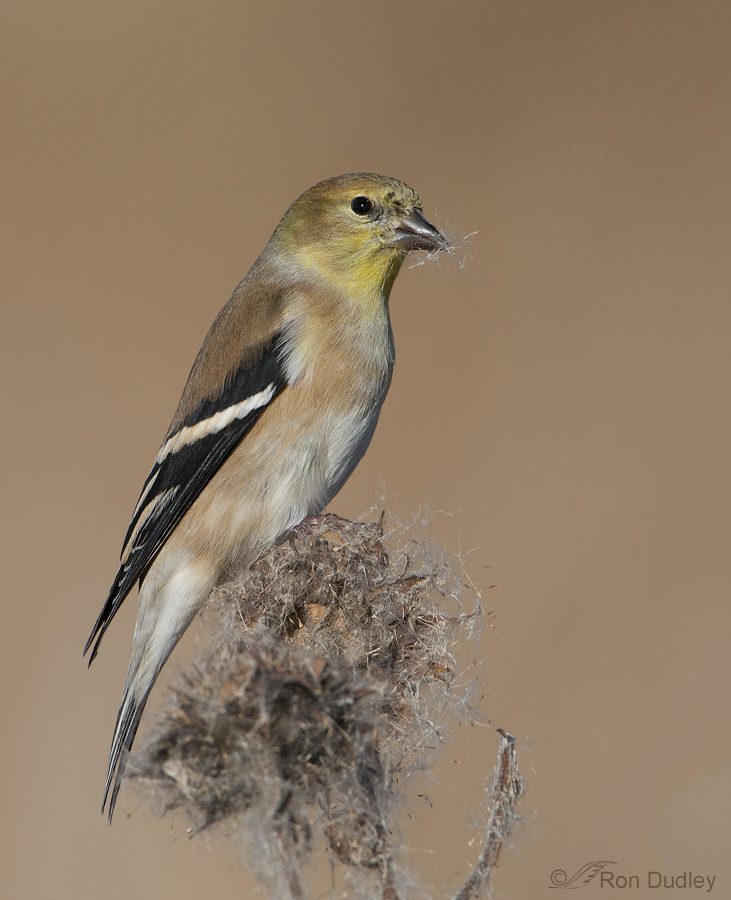
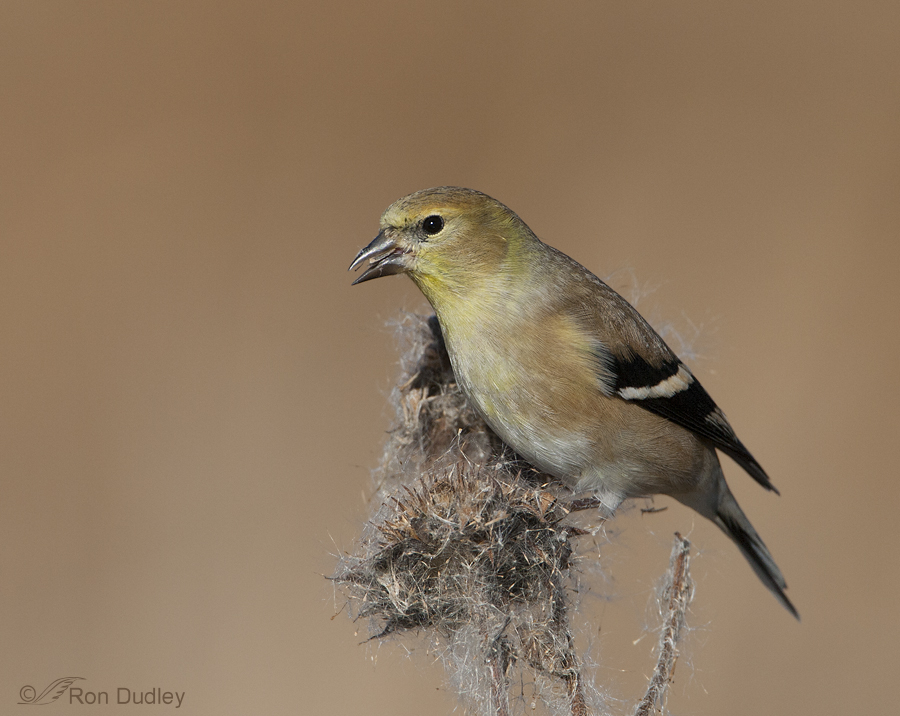
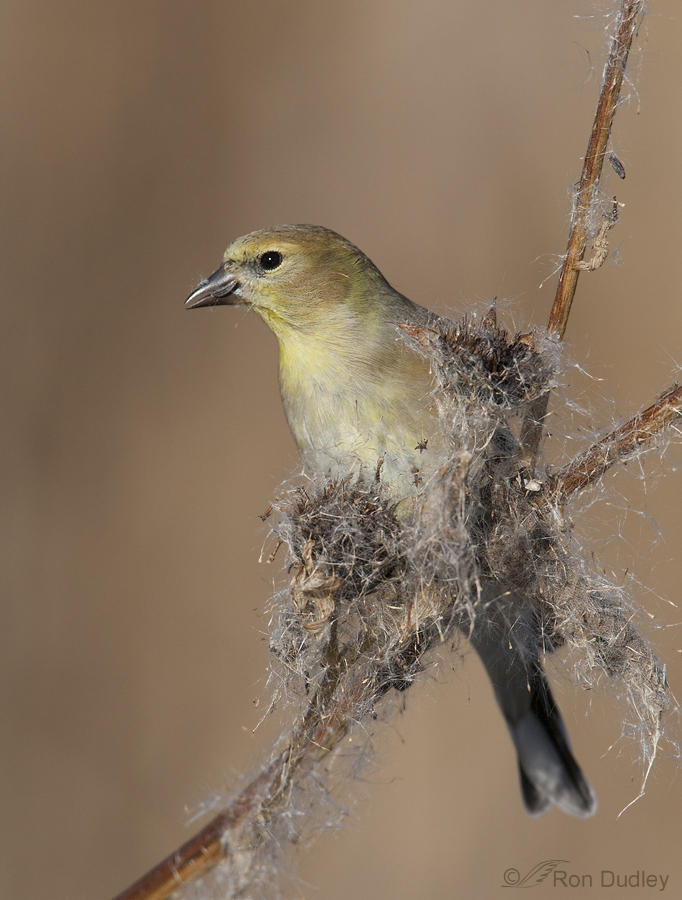
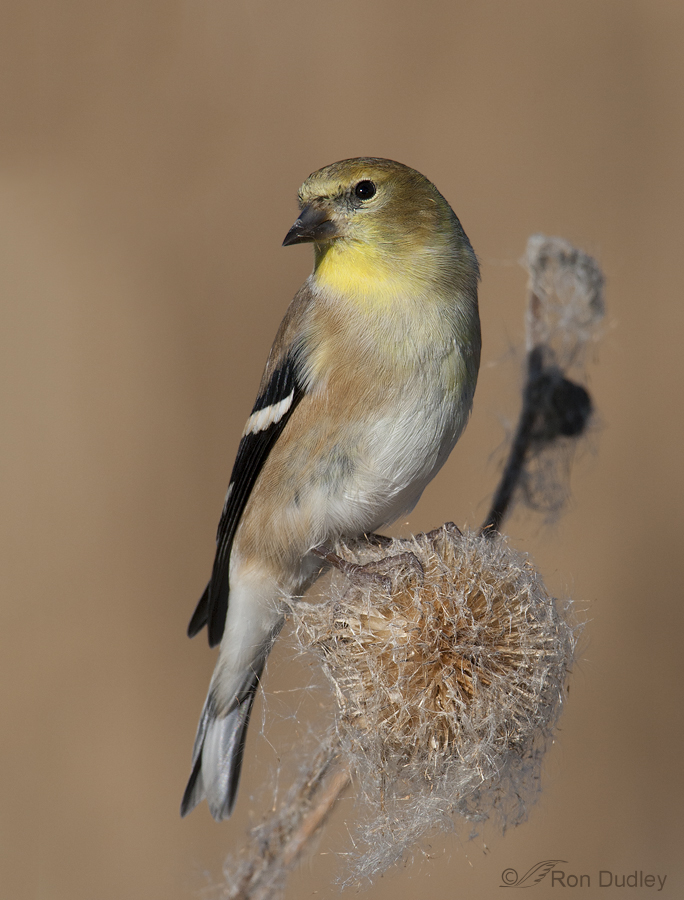
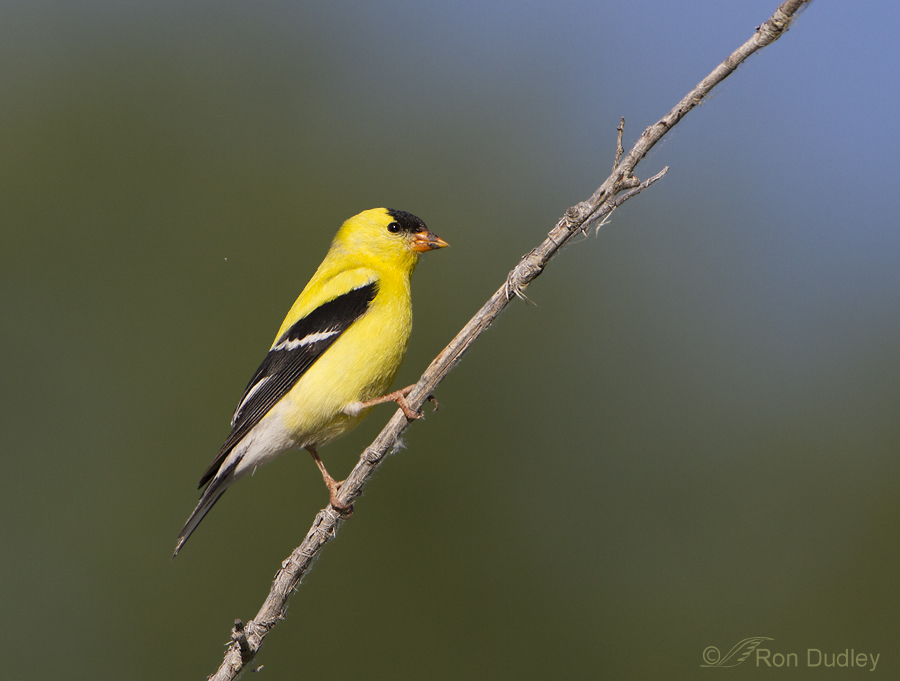
Ron, I am a newby appreciator to your over-the-top talents as a photographer, a naturalist and your built-in love and appreciation of all of God’s creation. What truly sets you apart, in my mind, is your humble, inquisitive, generous and delightful perspective on the world around you. You teach us all. Having recently moved to Fallbrook, CA my husband and I have become hungry students to all things living in our rural 2.5 acre, hill top plot. I once asked friends what kind of bird they would like to be. Wow! Talk about an insight into people’s personalities! Well, this is certaily a long way around telling you that my choice, hands down, was an American Goldfinch as they seem sweet natured, self sufficient, pretty and non aggressive. My husband, on the other hand, chose the Bullock’s Oriole as his pseudo personality…showy and fast! Lest I come across too gooey sweet, I should also tell you that I am a great appreciator of the Coyote…shrewd, fearless, and thirsty for the water hidden in our hoses. We now have a yard of ‘custom’ soaker hoses. I may come to regret this, but in self defense, I have recently set out a stainless, half buried, water bowl. :o) Thanks again Ron for the fresh delights you serve up every day!
Thanks very much for all the kind words, Cheryl. If I had to choose which bird I’d like to be I might choose the Prairie Falcon for a variety of reasons. And I know what you mean about the coyotes in your area as I used to live very close to you – Poway and Escondido.
Thanks, Ron…I just wanted Ingrid to enjoy the summer beauty of these exquisite little sun birds. When you see a flock of them flitting about in a patch of wild thistle, or clustered on a feeder, against a bright, blue-sky…and hear their sweet, sweet song, your winter weary heart flips with joy!
Ron–how about posting a picture of concentrated sunshine (aka the American Goldfinch male in spring/summer plumage) for Ingrid…and the test of us (just as a bonus)
Here it is, Patty – just for you (and for Ingrid)…
This coming Thursday, I have a lot to be thankful for…including you, Mia, your blog watchers…and BILL DOVE!!!
Patty and Ron: Thanks. My goal here on occasion is to simply wet people’s appitites to dig deeper themselves into many of the topics brought to our eyes and minds by Ron’s photographs. This group seems to have an interest in expanding their knowledge and understanding of birds and I want to help feed that. Some sites on the Internet seem to cater to prodominent groups that want to dumb down learning and information. Thankfully this is not one of them which I think is because Ron also encourages a deeper look at these animals both visually and mentally and recognizes we are all students.
Bill
Well said, Bill.
I am always open to learning new stuff – it is interesting, and helps me to make sense of the world. There is a world of difference between expressing concepts in understandable terms and dumbing down. I hope somebody will shoot me the day I lose interest in learning – hopefully I never will, because curiosity about the world and learning is what keeps us young and vital, no matter what our chronological age. I, too, appreciate your contributions to these discussions; you have helped me to understand a lot.
We are all student, kola…and we are all fauna…Mitakuye oyasin…
Hurray!! At long last a bird that (to my mind) is more beautiful here in the UK! You guys are so lucky with your birds over there
You ought to see our bird in breeding plumage, Ingrid!
Am so grateful that my aunt introduced your blog to me, Mia’s too… I’ve since passed it on to many others, and my children love your photos. We’re all grateful that you took up this “hobby” (the quality is professional)… I love goldfinches… I was so thrilled to see them in my backyard. I bragged to my Australian mother in law, who shrugged and said: meh, lorikeets are more colorful… Well, ha! I love them anyways… They’re “my” natives…
I’m glad your aunt introduced you also, Nicky. There’s just something about “natives”, isn’t there?
Do their beaks change color in the fall and winter (get darker)? I think the ones around here (the males at least)have pinkish beaks in the spring and summer.
Its common for the breeding males to have the pinkish mandibles.
Bill
I was hoping you’d tune in…and tell me HOW that can happen. Feathers of one color can molt and be replaced by those of another color…leading color change in plumage…but the beak is hard material…and isn’t shed/replaced…so how the heck can it change color???
Patty: Bills/mandibles are made up of bone with a sheath of keratin and there are numerous types of this protein that makes up the five types of feathers, beaks/mandibles and talons, claws and numerous other structures. (In humans hair and part of our skin structure.) Keratin also can have melanin which gives color to various structures like our skin, eyes, and hair. In birds it can give color to the bill/mandibles and feathers.
I believe the change in color of the male American Goldfinch is the result of DNA. Diet, photoperiod, and hormones from various parts of the endocrine system play a role as well (effecting what are known as secondary sexual characteristics).
BTW many other birds besides the AG display changes to their bills during their breeding season. Some species even shed portions of their bill to change the color of the bill.
This is complex stuff.
Bill
Bill
Wow! that explanatioln was terrific. Thanks for sharing. I have lots of gold finches in my yarfd. Everything on the males change color. Now I have an explanation as to why that happens. Thanks again.
Ellen
Thanks, Bill…I think ImALMOST get it…so, the color change happens in the SHEATH that covers the boneyard portion of the bill…but what’s in the keratin that change…I understand what happens in a leaf, but don’t understand things like Loren’s and beaks. Sorry to be so dense…
Patty: I wrote that late last evening (by my standards and didn’t want to write a book. LOL) Some of what I omitted are that the mandibles are alive. The sheath is growing continuously. Within the keratin is melanins and also carotenoids which are pigments. Various levels of different pigments create a result of different colors.
Birds control the growth of the sheath of their bills/beaks by working on hard surfaces like bones, seeds, and some vegetation. Us falconers use the term feaking to describe the behaviour of rubbing a raptors beak on hard objects for the purpose of cleaning and shaping.
Bill
OK, Bill (no pun intended), I think I’ve got it now…those were exactly the missing parts I needed to get the picture,,,guess I was feaking out a little trying to figure out the “mechanics”. Thanks for a nice, clear explanation that even an old bat like me can get a grasp the basics on…I am continually entranced, astounded, and amazed at nature’s ways! I’ll bet a lot of fellow ignoramuses appreciate this information, too. I thank you for them, too.
As do I, Bill. Very much appreciated!
It is your blog to post whatever birds tickle your fancy/float your boat on the day. That said, I have never, ever seen an image of yours where I have thought ‘boring’, ‘not x AGAIN’, ‘is his needle stuck?’. And I love the goldfinch and the fluff as well. Thank you.
Parasitic breeders are so very interesting. The adaptations their various species goes through to aid in success is interesting. I suggest the BH Cowbird must be a relativily new user of AG nests, although they use so many other species’ nests perhaps they haven’t reacted to the failures from AG sites.
Bill
These are lovely photos of a lovely bird. People really need to stop taking other people’s hard work and claim it as their own. Yes you have many many super pics but how hard is it to ask your permission and give you credit for all the hours you put into them.
Ron, sorry your problems with copyrights continue. We all want you to spent time taking photos not battling for your ownership. American goldfinches are sometimes called salad birds because they love to eat Swiss chard, beet tops and kale. Same as I do. Love the salad birds, one of which is enjoying water in my bird bath right now. I read they were obligate vegetarians but did not know about the cowbird connection. I always wondered what purpose their diet serves and nature always is purposeful. Thanks for the information
Your beginner shots are terrific. I have lots of gold finches in my yard year round. Sometimes they let me get really close. They are checking me out as I’m checking htem out and taking their pictures!! They are so fun fun to watch on sunflowers or on one of my finch feeders or taking baths. And when those males turn bright yellow in the spring…well, just truly amazing. Do you shoot in manuel mode?”
Thanks, Ellen. I always shoot in aperture priority.
Hi, Ron — Wow, you were starting out with these!! Amazing the talent you had right from the beginning, even as you’ve perfected it all. I once posted about how there’s hope for anyone (because of my horrible early shots). You’ve inspired me to revisit that topic just for fun.
Were you shooting similar gear then, too? What are some of the most profound insights about wildlife and photography you’ve had since that time?
Lastly, the copyright thing is such an unfortunate statement about human nature and what others will do given the opportunity. I hope this labor-intensive measure finally puts you in a more empowered position vis a vis these thieves. Sorry you had to go through that.
Thank you, Ingrid. These shots were taken with the same lens that I have now (soon after I got it). The camera was different but that wouldn’t make much difference with static shots like these. I got some good images almost from the beginning – one significant difference between then and now is my “keeper rate”. Experience has made it so that I now take far fewer garbage shots (though I still get my fair share).
I am so sorry to hear that you have still been encountering copyright infringement problems. It’s going to be worth all the effort you put into registering images in the long run.
I’m glad you explained what is covering the seed heads – would never have guessed phragmites. The way their seeds cling to things makes them look like spider webs to me. I love the feather detail that shows up on the birds. Great photos.
Susan, Copyright infringement is a beast that, given human nature, will never go away. I just have to deal with it as effectively as I’m able.
I love the soft, subtle colors of these cute, chatty little birds, much as I love the smooth, subtle colors of the female cardinals and the waxwings. I knew cottonwoods, milkweed and dandelions produced warm “snow”, but didn’t realize phragmites did, too. No wonder they are so wide spread! Sometimes I’m so obtuse about the obvious!!!
This is when you were just starting to learn bird photography?! Impressive. I look forward to seeing you pay more attention to song birds, Ron. And good for you, for registering your photos. It’s probably a pain, but I’m sure it is worthwhile.
as always, Ron, a joy to view!!! I love these little sweeties!!!
I do too. Thanks very much, Lois.
Great detail in the finch and super background!
Thank you, Bob.
Hi Ron, a little off topic but I thought images were automatically copyrighted to the photographer, this isn’t correct?
Thanks again for your outstanding blog!
They are, Bill. But if they’re not registered with the U.S. Copyright office the monetary compensation for infringement is relatively small, often making it not worth the time and effort for attorneys to take on the case. If they are registered the compensation goes up a lot and the infringer also has to pay legal fees.
One exception: if they’re not registered and the infringer REMOVED THE COPYRIGHT it can be worth it for the attorney to pursue the infringer.
Excellent shots Ron!! Many thanks for the information.
I’ve inspected several Goldfinch nests in the past, but have not seen a Cowbird egg.
I wonder whether here in the east Cowbirds have learned that their success is limited with parasitizing the nests of Goldfinches.
The most successful organisms aren’t the brightest, smartest but the ones that can adapt, and it seems to me that Cowbirds have learned to adapt.
An interesting thought, Dick. I’ve also wondered why the relatively protein-poor diet is fatal to the cowbirds but not to the goldfinches. Perhaps some kind of biological/physiological/genetic adaptation of goldfinches?…
Divine justice???
I’m unsure if it’s “divine”, Patty but there’s sure a lot of folks who would see it as some form of justice.
That’s how I see it, Patty. I’ve never cared much for cowbirds (or any other kind of parasite, either).
3 or 4 years ago we starting a Sunflower garden, and the Goldfinches started showing up. We have so many now. I love to listen to the Finches as they call to one another. Such a sweet voice. Wonderful pics!
I agree with you about their “voice”, Jean. Thank you.
They do have a really sweet song…in fact, it sounds like “sweet! Sweet! Sweet!” Is what they’re saying…
Yes, it does, Patty.
All beautiful photos, more bronze than goldfinches, which I like very much. Not a thing betrays your beginner status.
I wish everyone would state whether or not their photos were set up or audio playback was used. I don’t want to comment positively on a shot that depended on playback or set ups. Booo!
I feel EXACTLY the same way about setups of any kind, Kelly and that includes audio playback and baiting.
These are really stunning shots, and I like their coloration especially. The last one is my favourite. Some appealing textures too!
Thank you, Paul.
So sorry to hear about your continuing copyright infringement problems. I am glad you rediscovered these goldfinch images. They are lovely.
Thanks, Sharon. Registering all those images was a real pain but it’s now behind me and it should be much easier to keep up with current images.